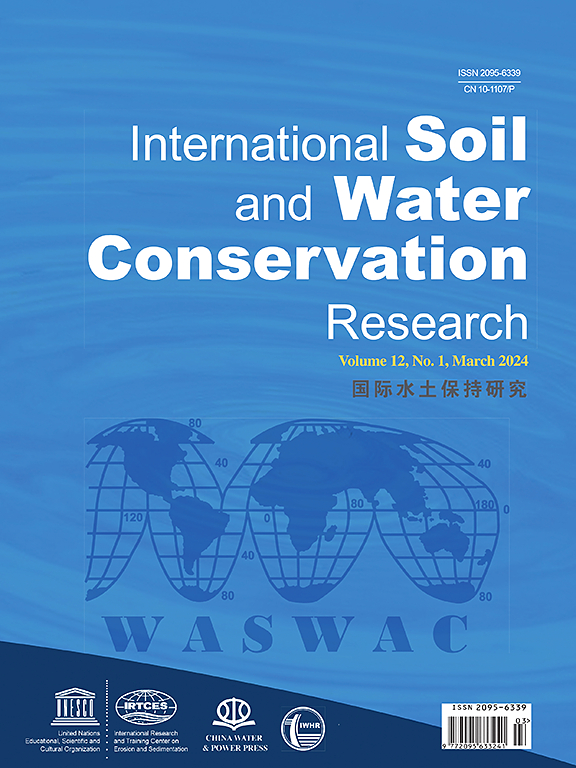Assessing the declining trend in soil erodibility across China: A comparison of conventional and digital K-factor maps
IF 7.3
1区 农林科学
Q1 ENVIRONMENTAL SCIENCES
International Soil and Water Conservation Research
Pub Date : 2024-05-29
DOI:10.1016/j.iswcr.2024.05.005
引用次数: 0
Abstract
Soil erodibility is a measure of soil susceptibility to water erosion and serves as an essential element, also known as the K-factor, in empirical soil erosion prediction models, such as USLE, RUSLE, and CSLE. The currently available map of the K-factor for China was generated based on the conventional soil polygon linkage method and soil species survey conducted in the 1980s. For update, an investigation of 4262 samples from the soil series survey in the 2010s and a random forest regression model were used to generate a new K-factor map for China. A digital K-factor map at the 250 m spatial resolution was generated by calculating the K values from soil survey points as training data and using environmental information as predictive variables. The comparison results between the digital and conventional K-factor maps show that there has been a decreasing trend in the K-factor over recent decades. The K value decrease was mainly attributed to the update of soil survey data (the mean K value changed from 0.03193 t ha·h/(MJ·mm·ha) in the soil species database to 0.02988 t ha·h/(MJ·mm·ha) in the soil series) and was less influenced by the replacement of the mapping methods (the mean K value changed from 0.03197 t ha·h/(MJ·mm·ha) in the soil polygon linkage method to 0.03193 t ha·h/(MJ·mm·ha) in the random forest). This study quantified the sources of change between previous and updated national K-factor maps and demonstrated that there is a decreasing trend in K values, which is consistent with the increasing soil organic matter and improved ecological environment in China.

中国土壤可蚀性下降趋势评估:传统k因子图与数字k因子图的比较
土壤可蚀性是衡量土壤对水分侵蚀敏感性的指标,在USLE、RUSLE和CSLE等经验土壤侵蚀预测模型中是一个基本要素,也称为k因子。中国目前可用的k因子图谱是基于20世纪80年代进行的土壤物种调查和传统的土壤多边形联系方法生成的。本文利用2010年代土壤系列调查的4262个样本,利用随机森林回归模型生成了新的中国k因子图。以土壤调查点为训练数据,以环境信息为预测变量,计算K值,生成250 m空间分辨率的数字K因子图。数字k因子图与传统k因子图的比较结果表明,近几十年来,k因子呈下降趋势。K值下降的主要原因是土壤调查数据的更新(土壤物种数据库的平均K值从0.03193 t ha·h/(MJ·mm·ha)变化到土壤系列的0.02988 t ha·h/(MJ·mm·ha)),受作图方法更换的影响较小(土壤多面体链接法的平均K值从0.03197 t ha·h/(MJ·mm·ha)变化到随机森林的0.03193 t ha·h/(MJ·mm·ha))。本研究量化了以往与更新后的国家K因子图之间的变化来源,结果表明,中国土壤K值呈下降趋势,这与土壤有机质增加和生态环境改善是一致的。
本文章由计算机程序翻译,如有差异,请以英文原文为准。
求助全文
约1分钟内获得全文
求助全文
来源期刊

International Soil and Water Conservation Research
Agricultural and Biological Sciences-Agronomy and Crop Science
CiteScore
12.00
自引率
3.10%
发文量
171
审稿时长
49 days
期刊介绍:
The International Soil and Water Conservation Research (ISWCR), the official journal of World Association of Soil and Water Conservation (WASWAC) http://www.waswac.org, is a multidisciplinary journal of soil and water conservation research, practice, policy, and perspectives. It aims to disseminate new knowledge and promote the practice of soil and water conservation.
The scope of International Soil and Water Conservation Research includes research, strategies, and technologies for prediction, prevention, and protection of soil and water resources. It deals with identification, characterization, and modeling; dynamic monitoring and evaluation; assessment and management of conservation practice and creation and implementation of quality standards.
Examples of appropriate topical areas include (but are not limited to):
• Conservation models, tools, and technologies
• Conservation agricultural
• Soil health resources, indicators, assessment, and management
• Land degradation
• Sustainable development
• Soil erosion and its control
• Soil erosion processes
• Water resources assessment and management
• Watershed management
• Soil erosion models
• Literature review on topics related soil and water conservation research
 求助内容:
求助内容: 应助结果提醒方式:
应助结果提醒方式:


